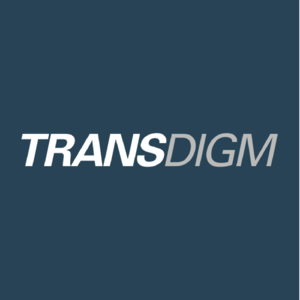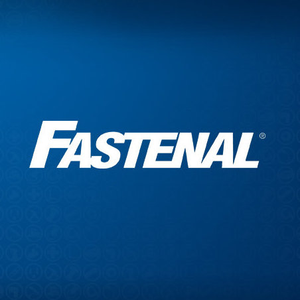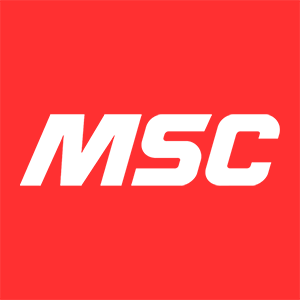
Distribution Solutions (DSGR)
We admire Distribution Solutions. Its exceptional revenue growth indicates it’s winning market share.― StockStory Analyst Team
1. News
2. Summary
Why We Like Distribution Solutions
Founded in 1952, Distribution Solutions (NASDAQ:DSGR) provides supply chain solutions and distributes industrial, safety, and maintenance products to various industries.
- Market share has increased this cycle as its 39.5% annual revenue growth over the last four years was exceptional
- Earnings per share grew by 34.8% annually over the last two years, massively outpacing its peers
- Solid gross margin and unit economics free up capital for marketing and product development efforts


We expect great things from Distribution Solutions. The valuation looks reasonable in light of its quality, so this could be a good time to buy some shares.
Why Is Now The Time To Buy Distribution Solutions?
High Quality
Investable
Underperform
Why Is Now The Time To Buy Distribution Solutions?
Distribution Solutions is trading at $28.70 per share, or 18x forward P/E. The valuation multiple is below many companies in the industrials sector. We therefore think the stock is a good deal for the fundamentals.
Where you buy a stock impacts returns. Our analysis shows that business quality is a much bigger determinant of market outperformance over the long term compared to entry price, but getting a good deal on a stock certainly isn’t a bad thing.
3. Distribution Solutions (DSGR) Research Report: Q3 CY2025 Update
Industrial and safety product distributor Distribution Solutions (NASDAQ:DSGR) announced better-than-expected revenue in Q3 CY2025, with sales up 10.7% year on year to $518 million. Its non-GAAP profit of $0.40 per share was in line with analysts’ consensus estimates.
Distribution Solutions (DSGR) Q3 CY2025 Highlights:
- Revenue: $518 million vs analyst estimates of $501.5 million (10.7% year-on-year growth, 3.3% beat)
- Adjusted EPS: $0.40 vs analyst estimates of $0.40 (in line)
- Adjusted EBITDA: $48.46 million vs analyst estimates of $50.17 million (9.4% margin, 3.4% miss)
- Operating Margin: 4.6%, in line with the same quarter last year
- Free Cash Flow was $40.04 million, up from -$23.02 million in the same quarter last year
- Market Capitalization: $1.38 billion
Company Overview
Founded in 1952, Distribution Solutions (NASDAQ:DSGR) provides supply chain solutions and distributes industrial, safety, and maintenance products to various industries.
Distribution Solutions was established to streamline and enhance the supply chain for industrial and safety products. With a history of addressing product distribution, the company has evolved to offer various solutions.
Today, the company provides industrial supplies, safety equipment, and maintenance products to customers in various industries, ensuring businesses have the necessary tools and materials to maintain operational efficiency and safety. For example, manufacturing firms rely on Distribution Solutions's delivery of essential components to avoid production delays, while construction companies depend on their safety gear to protect workers on-site.
Revenue sources for Distribution Solutions include sales of industrial and safety products, along with value-added services such as inventory management and logistics support. The business model focuses on building customer relationships through direct sales and a distribution network. Recurring revenue is driven by long-term contracts and repeat business from customers for replacement parts.
4. Maintenance and Repair Distributors
Supply chain and inventory management are themes that grew in focus after COVID wreaked havoc on the global movement of raw materials and components. Maintenance and repair distributors that boast reliable selection and quickly deliver products to customers can benefit from this theme. While e-commerce hasn’t disrupted industrial distribution as much as consumer retail, it is still a real threat, forcing investment in omnichannel capabilities to serve customers everywhere. Additionally, maintenance and repair distributors are at the whim of economic cycles that impact the capital spending and construction projects that can juice demand.
Competitors in the industrial products industry include Grainger (NYSE:GWW), Fastenal (NASDAQ:FAST), and MSC Industrial (NYSE:MSM)
5. Revenue Growth
A company’s long-term sales performance can indicate its overall quality. Any business can put up a good quarter or two, but the best consistently grow over the long haul. Thankfully, Distribution Solutions’s 39.5% annualized revenue growth over the last four years was incredible. Its growth beat the average industrials company and shows its offerings resonate with customers, a helpful starting point for our analysis.
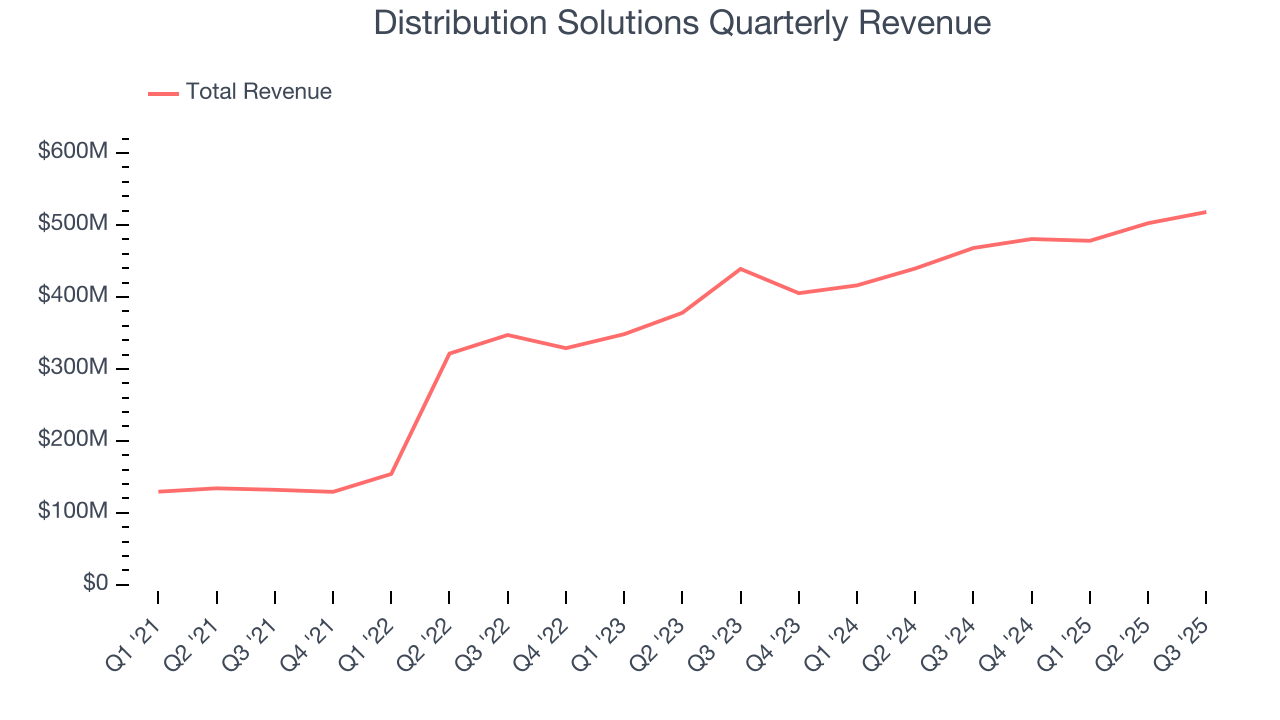
We at StockStory place the most emphasis on long-term growth, but within industrials, a stretched historical view may miss cycles, industry trends, or a company capitalizing on catalysts such as a new contract win or a successful product line. Distribution Solutions’s annualized revenue growth of 15.1% over the last two years is below its four-year trend, but we still think the results suggest healthy demand. 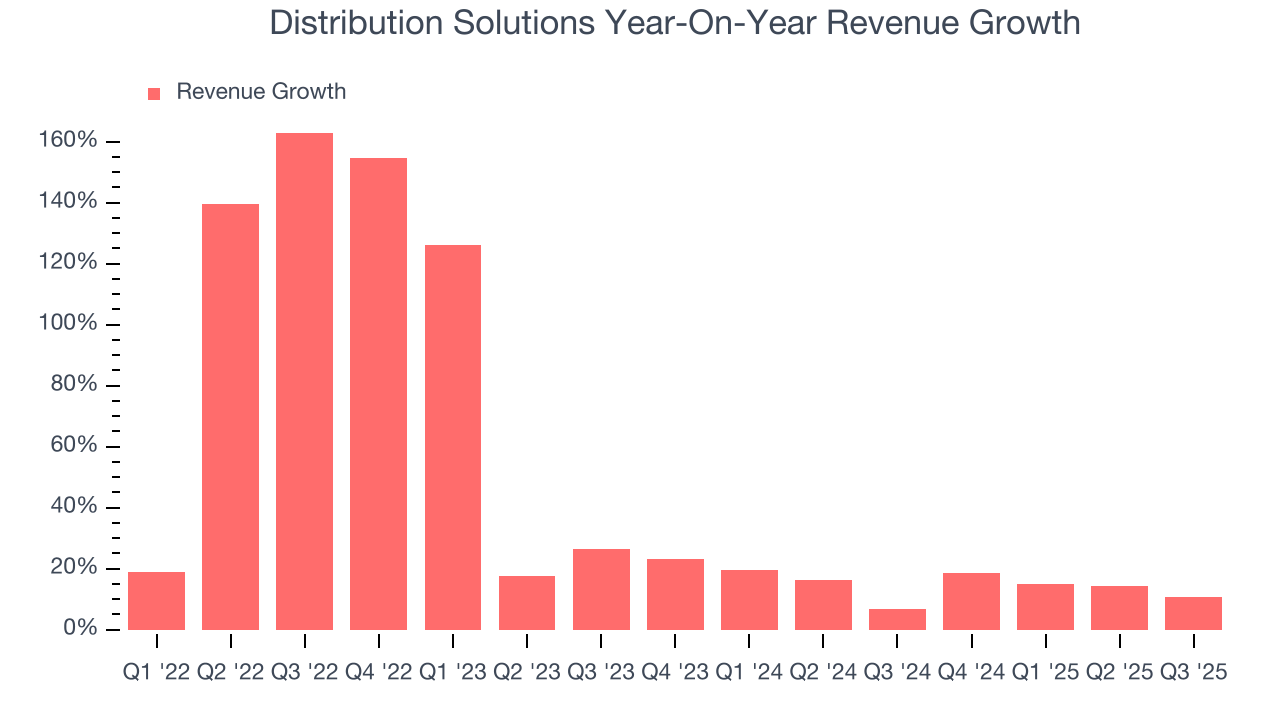
This quarter, Distribution Solutions reported year-on-year revenue growth of 10.7%, and its $518 million of revenue exceeded Wall Street’s estimates by 3.3%.
Looking ahead, sell-side analysts expect revenue to grow 2.8% over the next 12 months, a deceleration versus the last two years. This projection doesn't excite us and indicates its products and services will face some demand challenges. At least the company is tracking well in other measures of financial health.
6. Gross Margin & Pricing Power
At StockStory, we prefer high gross margin businesses because they indicate the company has pricing power or differentiated products, giving it a chance to generate higher operating profits.
Distribution Solutions’s gross margin is good compared to other industrials businesses and signals it sells differentiated products, not commodities. As you can see below, it averaged an impressive 33.6% gross margin over the last five years. Said differently, Distribution Solutions paid its suppliers $66.41 for every $100 in revenue. 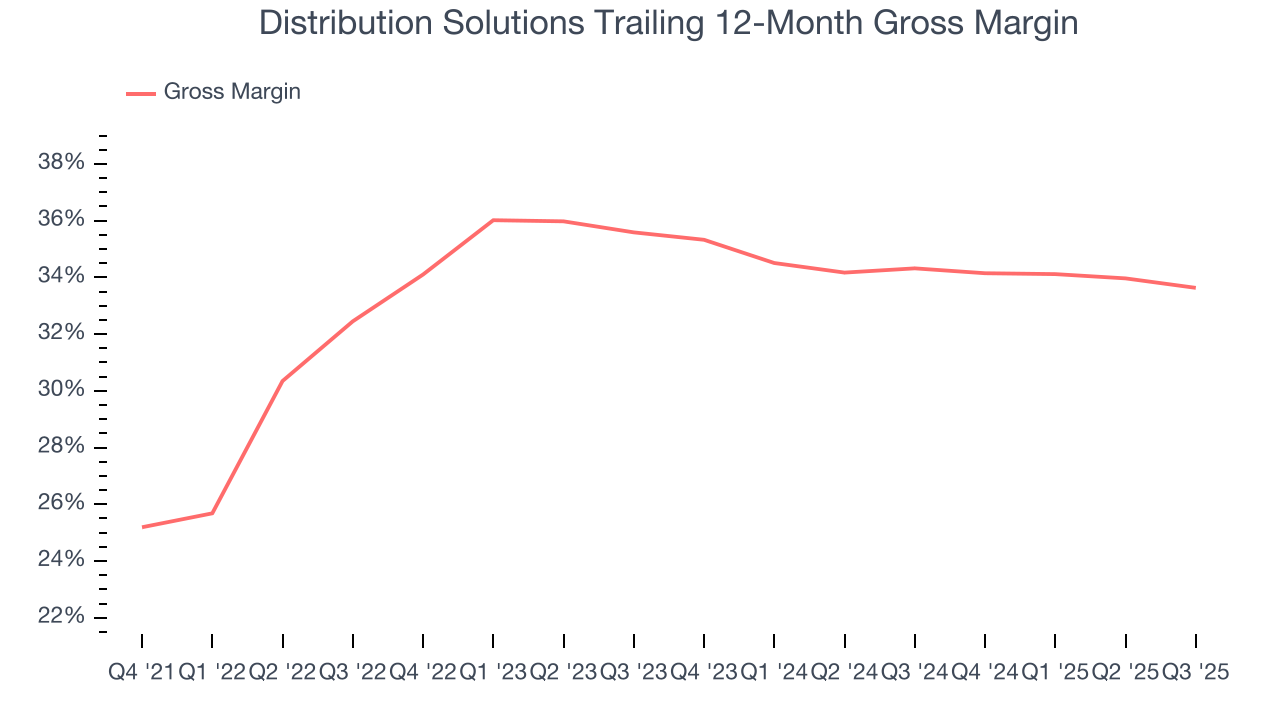
In Q3, Distribution Solutions produced a 32.9% gross profit margin, down 1.3 percentage points year on year. On a wider time horizon, the company’s full-year margin has remained steady over the past four quarters, suggesting its input costs (such as raw materials and manufacturing expenses) have been stable and it isn’t under pressure to lower prices.
7. Operating Margin
Operating margin is one of the best measures of profitability because it tells us how much money a company takes home after procuring and manufacturing its products, marketing and selling those products, and most importantly, keeping them relevant through research and development.
Distribution Solutions’s operating margin might fluctuated slightly over the last 12 months but has remained more or less the same, averaging 5.2% over the last five years. This profitability was paltry for an industrials business and caused by its suboptimal cost structure.
Looking at the trend in its profitability, Distribution Solutions’s operating margin might fluctuated slightly but has generally stayed the same over the last five years. This raises questions about the company’s expense base because its revenue growth should have given it leverage on its fixed costs, resulting in better economies of scale and profitability.
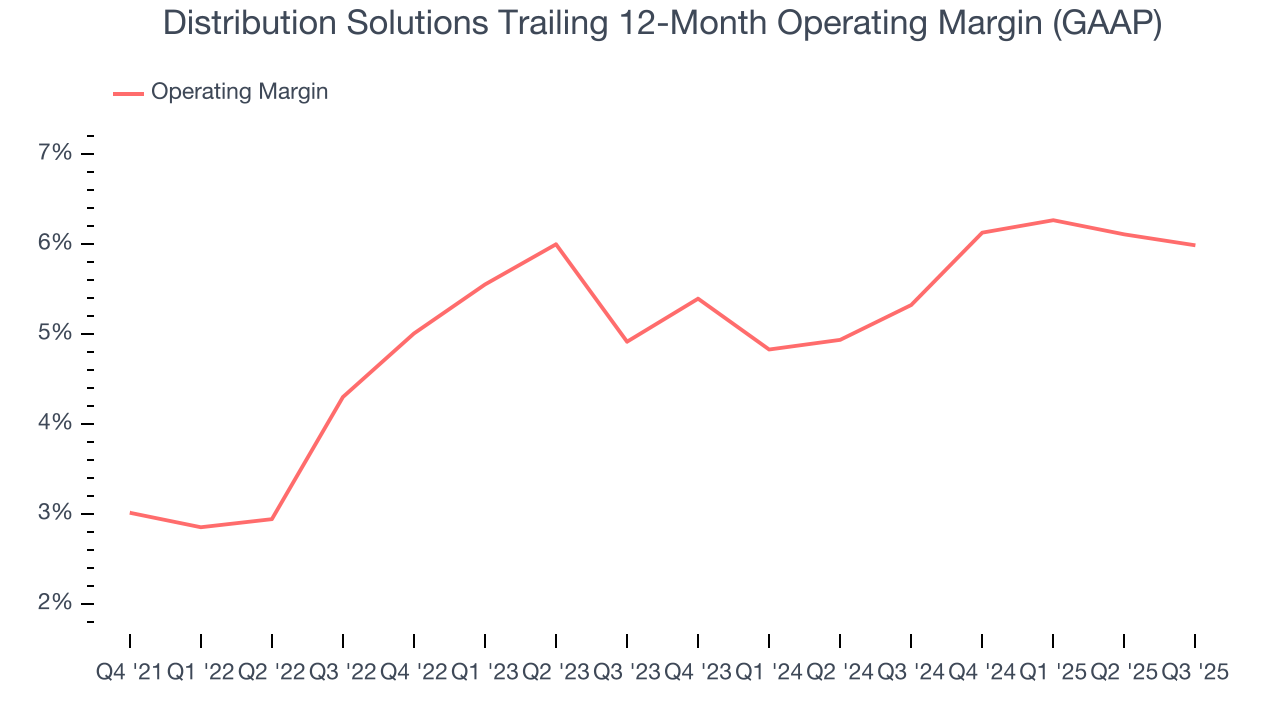
In Q3, Distribution Solutions generated an operating margin profit margin of 4.6%, in line with the same quarter last year. This indicates the company’s cost structure has recently been stable.
8. Cash Is King
Although earnings are undoubtedly valuable for assessing company performance, we believe cash is king because you can’t use accounting profits to pay the bills.
Distribution Solutions has shown poor cash profitability over the last five years, giving the company limited opportunities to return capital to shareholders. Its free cash flow margin averaged 1.7%, lousy for an industrials business.
Taking a step back, an encouraging sign is that Distribution Solutions’s margin expanded by 1.9 percentage points during that time. The company’s improvement shows it’s heading in the right direction, and we can see it became a less capital-intensive business because its free cash flow profitability rose while its operating profitability was flat.
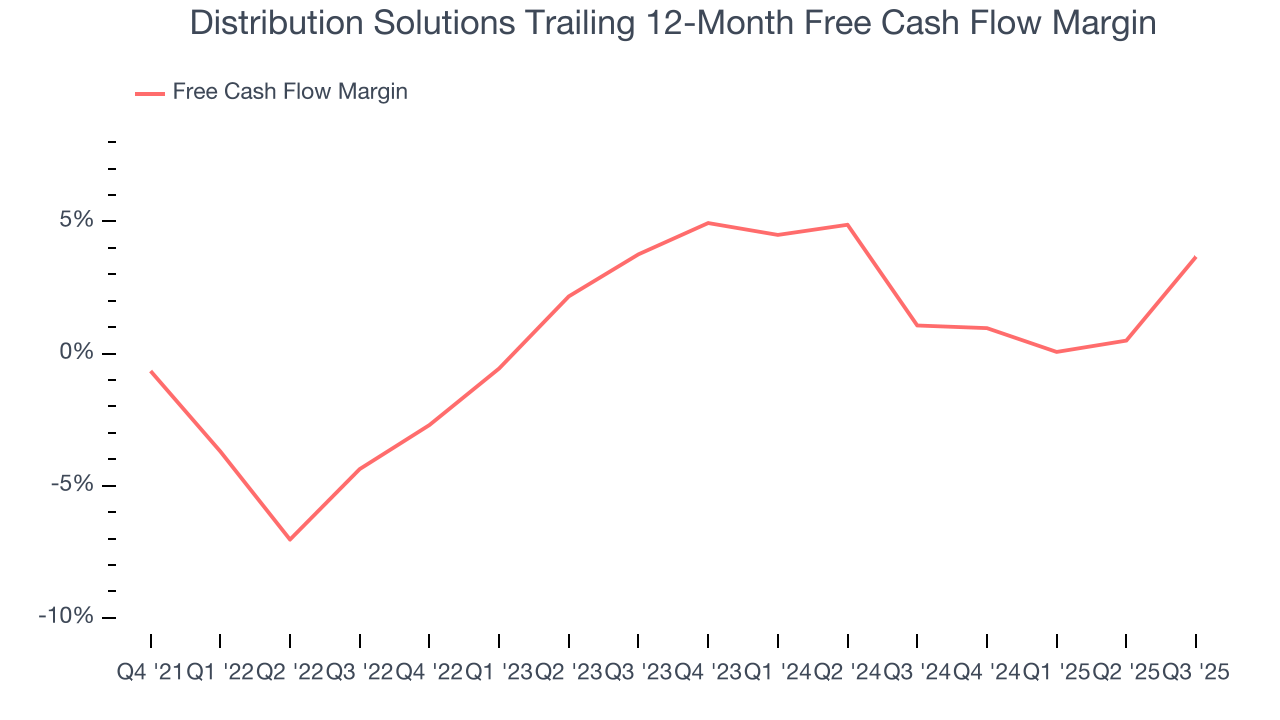
Distribution Solutions’s free cash flow clocked in at $40.04 million in Q3, equivalent to a 7.7% margin. Its cash flow turned positive after being negative in the same quarter last year, building on its favorable historical trend.
9. Balance Sheet Assessment
Distribution Solutions reported $69.21 million of cash and $821.2 million of debt on its balance sheet in the most recent quarter. As investors in high-quality companies, we primarily focus on two things: 1) that a company’s debt level isn’t too high and 2) that its interest payments are not excessively burdening the business.
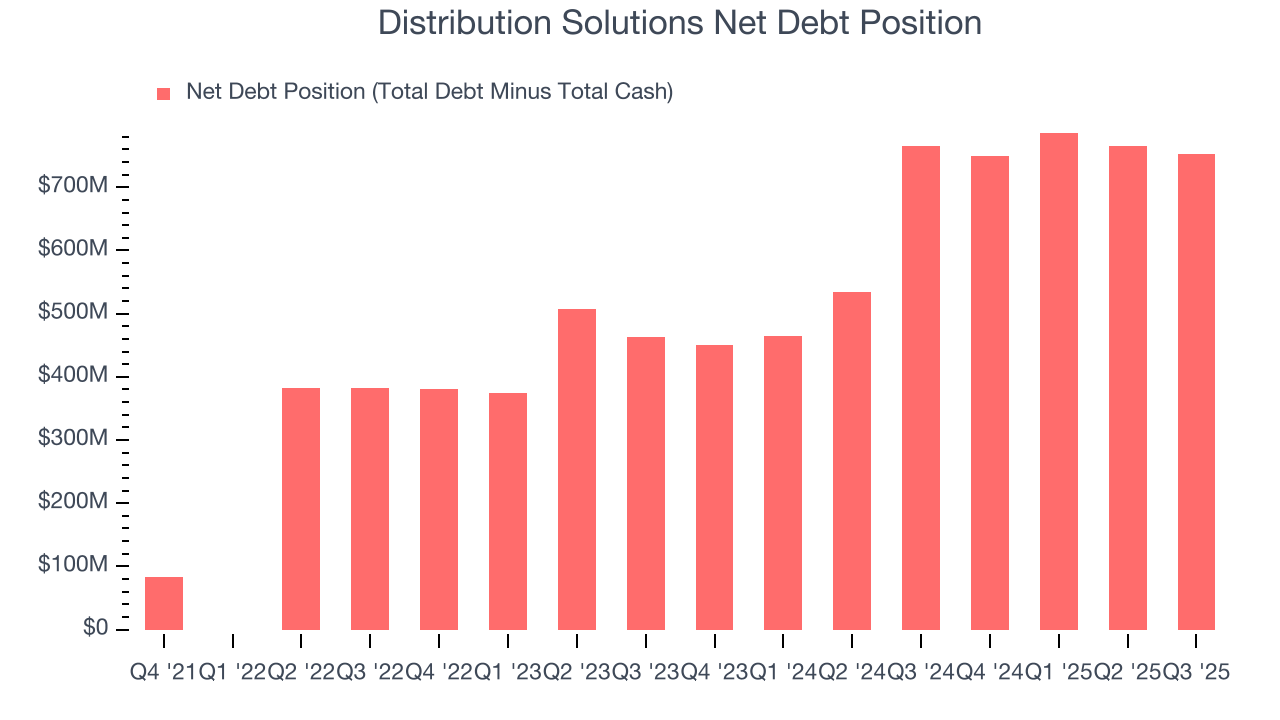
With $184.7 million of EBITDA over the last 12 months, we view Distribution Solutions’s 4.1× net-debt-to-EBITDA ratio as safe. We also see its $29.86 million of annual interest expenses as appropriate. The company’s profits give it plenty of breathing room, allowing it to continue investing in growth initiatives.
10. Key Takeaways from Distribution Solutions’s Q3 Results
We enjoyed seeing Distribution Solutions beat analysts’ revenue expectations this quarter. On the other hand, its EBITDA missed. Zooming out, we think this was a mixed quarter. The stock remained flat at $29.76 immediately following the results.
11. Is Now The Time To Buy Distribution Solutions?
Updated: December 24, 2025 at 10:31 PM EST
The latest quarterly earnings matters, sure, but we actually think longer-term fundamentals and valuation matter more. Investors should consider all these pieces before deciding whether or not to invest in Distribution Solutions.
Distribution Solutions is a rock-solid business worth owning. For starters, its revenue growth was exceptional over the last four years. And while its low free cash flow margins give it little breathing room, its astounding EPS growth over the last two years shows its profits are trickling down to shareholders. On top of that, Distribution Solutions’s gross margins are decent for a industrials business.
Distribution Solutions’s P/E ratio based on the next 12 months is 18x. Looking at the industrials landscape today, Distribution Solutions’s fundamentals really stand out, and we like it at this price.
Wall Street analysts have a consensus one-year price target of $38.50 on the company (compared to the current share price of $28.70), implying they see 34.1% upside in buying Distribution Solutions in the short term.
